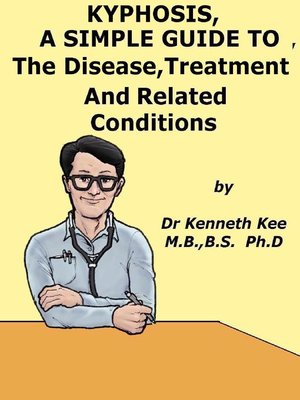
Sign up to save your library
With an OverDrive account, you can save your favorite libraries for at-a-glance information about availability. Find out more about OverDrive accounts.
Find this title in Libby, the library reading app by OverDrive.



Search for a digital library with this title
Title found at these libraries:
| Library Name | Distance |
|---|---|
| Loading... |
Kyphosis is a curving of the spine that causes a bowing or rounding of the back which leads to a hunchback or slouching posture.
Kyphosis can occur at any age although it is rare at birth.
Adolescent kyphosis, also known as Scheuermann's disease, is caused by the wedging together of several bones of the spine (vertebrae) in a row.
The cause of Scheuermann's disease is unknown.
In adults, kyphosis can be caused by:
1. Degenerative diseases of the spine (such as arthritis or disk degeneration)
2. Fractures caused by osteoporosis (osteoporotic compression fractures)
3. Injury (trauma)
4. Slipping of one vertebra forward on another
Other causes of kyphosis include:
5. Certain endocrine diseases
6. Connective tissue disorders
7. Infection (such as tuberculosis)
8. Muscular dystrophy
9. Neurofibromatosis
10. Paget's disease
11. Polio
12. Spina bifida
13. Tumors
Kyphosis can also be seen with scoliosis.
Symptoms are:
1. Difficulty breathing (in severe cases)
2. Fatigue
3. Mild back pain
4. Round back appearance
5. Tenderness and stiffness in the spine
The doctor will also look for any:
1. Nervous system (neurological) changes (weakness, paralysis, or changes in sensation) below the curve.
2. Spine x-ray
3. Pulmonary function tests (if kyphosis affects breathing)
4. MRI (if there may be a tumor, infection, or neurological symptoms)
Congenital kyphosis requires corrective surgery at an early age.
Scheuermann's disease is treated with a brace and physical therapy.
Occasionally surgery is needed for large (greater than 60 degrees), painful curves.
Multiple compression fractures from osteoporosis can be left alone if there are no nervous system problems or pain.
However, the osteoporosis needs to be treated to help prevent future fractures
Complications are:
1. Decreased lung capacity
2. Disabling back pain
3. Neurological symptoms including leg weakness or paralysis
TABLE OF CONTENT
Introduction
Chapter 1 Kyphosis
Chapter 2 More Facts of Kyphosis
Chapter 3 Treatment of Kyphosis
Chapter 4 Kyphoscoliosis
Chapter 5 Scoliosis
Chapter 6 Osteoporosis
Chapter 7 Costochondrosis
Chapter 8 Pectus Excavatum
Chapter 9 Pectus Carinatum
Epilogue







